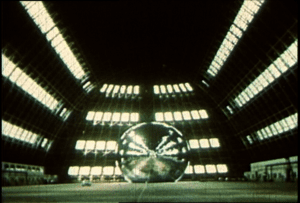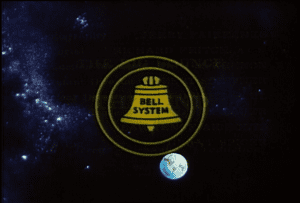Orphans in Space: Forgotten Films from the Final Frontier
special edition for Roger That! 2021
The Big Bounce (Jerry Fairbanks, 1960) 
15 min., color, sound.
Source: Prelinger Archives
In addition to its time-capsulation of telecommunications in the early space age, The Big Bounce represents two important forces in postwar sponsored films: the American Telephone and Telegraph Company and Jerry Fairbanks Productions. AT&T and its Bell System subsidiaries regularly commissioned films to shape the corporation’s relationship to consumers. Many aimed at manners, such as Party Lines (1947, etiquette for sharing telephone lines), Adventure in Telezonia (1949, directory assistance), The Nation at Your Fingertips (1951, dialing long-distance), and Telephone: A Manner of Speaking (1959, efficient use of office telephones). Some promoted consumption, notably the elaborate Fairbanks musical production Once Upon A Honeymoon (1956, idealizing color decorator phones). Others advanced AT&T’s identity as innovator, including Stepping Along with Television (1949, coaxial cable and microwave relay) and Incredible Machine (1968, Bell Labs computer graphics and computer-generated movies). Still others demonstrated the company’s role in the military-industrial complex, such as Seconds for Survival (1960, telephony within national defense mechanisms). The AT&T Archives and History Center hosts dozens of such films on its website.
Fairbanks Productions in Hollywood produced several of the most elaborate AT&T/Bell films. Jerry Fairbanks himself left Paramount Pictures to found a company that specialized in work for hire, but which offered resources on the scale of a Hollywood studio. The promotional short An Old Chinese Proverb: One Picture Is Worth 10,000 Words (1946) is a Fairbanks production documenting the operations of its studio. In addition to The Big Bounce and Once Upon a Honeymoon, the company made Century 21 Calling (1963). Shot at the 1962 Seattle World’s Fair, it shows off AT&T technologies and consumer products: Touch-Tone phones, radio pagers, and remote-controlled appliances.
 The Bell System Science Series hired Hollywood names as well. Reaching both television and the educational film market, Frank Capra produced the touchstone science education films Our Mr. Sun (1956), Hemo the Magnificent (1957) and four others. The Bell Telephone System went so far as to set up its own distribution libraries for regional film rentals. All told, AT&T sponsored work by a range of talents from all sectors of cinema. In addition to its industrial and Hollywood hires, the company supported experimental work (by Stan VanDerBeek, Ken Knowlton, Lillian Schwartz, Michael Noll, Hollis Frampton) and top documentarians (see director Nell Cox’s exceptional recruiting film Operator, made in 1969 and shot by Ricky Leacock).
The Bell System Science Series hired Hollywood names as well. Reaching both television and the educational film market, Frank Capra produced the touchstone science education films Our Mr. Sun (1956), Hemo the Magnificent (1957) and four others. The Bell Telephone System went so far as to set up its own distribution libraries for regional film rentals. All told, AT&T sponsored work by a range of talents from all sectors of cinema. In addition to its industrial and Hollywood hires, the company supported experimental work (by Stan VanDerBeek, Ken Knowlton, Lillian Schwartz, Michael Noll, Hollis Frampton) and top documentarians (see director Nell Cox’s exceptional recruiting film Operator, made in 1969 and shot by Ricky Leacock).
[vimeo 495939742 w=640 h=480]
or go to vimeo.com/495939742
—
Dan Streible wrote these notes, relying on Rick Prelinger’s invaluable book The Field Guide to Sponsored Films (National Film Preservation Foundation, 2006).
Preservation note
Prelinger Archives provided a DigiBeta videotape made from a 16mm release print. Originally produced in 35mm, The Big Bounce was probably shot on Eastmancolor negative stock. However labs struck Technicolor prints for both 35mm and 16mm distribution. The Prelinger Archives copy is one of the so-called “I.B. Tech” prints, made with a three-color dye transfer process (imbibition, or I.B.), known for its long-lasting and rich colors.